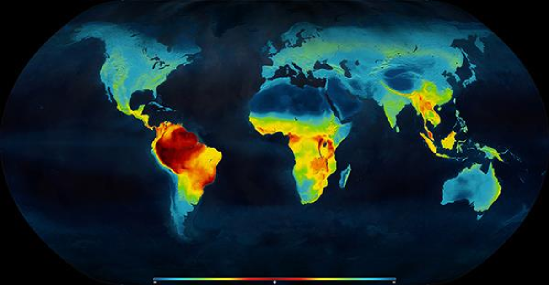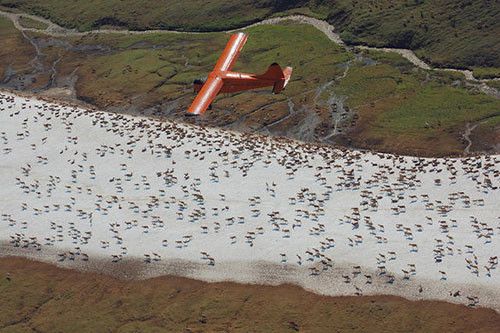Welcome to
Principles of Ecology
What questions come to your mind?


How many bats live in this group?
Course Introduction
About me
Quantitative plant ecologist and educator
Research focus: How are the above-ground dynamics of plant communities affected by below-ground microorganisms?
How to call me: Dr. Kandlikar (like “candy car”, but “candly-car”), or Dr. G, or Dr. K, or Gaurav
Photo by Gaurav, of Tejon Ranch in southern California
Photo by Gaurav, of a forest canopy in south India
Photo by Gaurav, of lab members in a longleaf pine savanna in Louisiana
Appproaches to ecology

Find out more at gklab.org:
I want to get to know you!
Please fill out the “Who’s in class” survey on Moodle!
What does “Ecology” mean to you?
What is Ecology?
Ecology as a discipline is motivated by human efforts to
describe, understand, predict, and modify nature.
Contemporary ecology research aims to understand
the factors that shape where organisms live,
how their abundances change over time,
how interactions shape communities and ecosystems,
and how these are affected by global environmental change.
This course will introduce you to the questions that motivate the field of ecology, the approaches that ecologists take, and the implications of ecological research for societal challenges.
How many bats live in this group?
How many bats live in this group?
Why is this simple question not very simple to answer?
Some complicating factors:
- Our brains are bad at processing big (or small) numbers
- Population size changes over time – so, when do we want to know?
- The bats don’t exist in a vacuum – how do interactions (with other organisms, with human decisions, etc.) shape this population?
Photo by Matej Spulak on Unsplash
Common themes in ecology
- Ecological systems are dynamic, meaning that their properties can change over time.
- Ecological systems are structured by feedacks, meaning that the dynamics of one component often affects others.
- Understanding ecological systems requires us to confront uncertainty, which can arise for various reasons.
- The dynamics and wellbeing of ecological systems are tightly intertwined with the wellbeing of human societies.
Photo by Matej Spulak on Unsplash
Over the semester, you will develop skills to:
- Describe how the field of ecology tackles complexity
- Explain how mathematical thinking helps generate
ecological insights - Interpret figures and results from published ecological literature
- Discuss the role of ecology in addressing major societal challenges.
Photo by Matej Spulak on Unsplash
Over the semester, you will develop skills to:
- Describe how the field of ecology tackles complexity
- Explain how mathematical thinking helps generate ecological insights
- Interpret figures and results from published ecological literature
- Discuss the role of ecology in addressing major societal challenges.
How many bats live in this group?
- Mark-Recapture as a method to estimate of population size:
- Capture and mark (tag) some number of individuals
- Release tagged individuals and allow the population to re-equilibrate
- Once population is settled (e.g. in the case of bats - on a different night), capture some number of individuals
- The proportion of individuals that are marked in your second sample can give you a good estimate of the total population size
How many bats live in this group?
Mark-Recapture as a method to estimate of population size:
\(N_{Marked}\): number of individuals marked in first sample
\(N_{Captured}\): number of individuals captured in second sample
\(N_{Captured,\ Marked}\): number of individuals in the second sample that are marked
\(N_{Total,\ Estimated}\): estimate of total population size
\[N_{Total,\ Estimated} = \frac{N_{Marked}*N_{Captured}}{N_{Captured,\ Marked}}\]
Worked example
On your first sampling day, you mark 200 bats with a metallic tag (\(N_{Marked} = 200\))
You return to the bridge next week, and capture 1500 bats (\(N_{Captured} = 1500\))
Of the 1500, only 17 bear the metallic tag mark (\(N_{Captured,\ Marked} = 17\))
Intuition: Since you marked 200 bats initially and only recaptured 17 in a large sample of 1500, you were only able to mark a small fraction of the bats!
\[N_{Total,\ Estimated} = \frac{N_{Marked}*N_{Captured}}{N_{Captured,\ Marked}} = \frac{200*1500}{17} \approx 17647 \mathrm{\ bats}\]
Principles of Ecology
Course structure
What are we here to learn?
Note about slides
You can download the slides as a PDF:
- Navigate to the slides webpage
- click the
ebutton on your keyboard - click
ctrl+pto “print” the slides as a PDF file.
What is Ecology?
Ecology as a discipline is motivated by human efforts to
describe, understand, predict, and modify nature.Contemporary ecology research aims to understand
the factors that shape where organisms live,
how their abundances change over time,
how interactions shape communities and ecosystems,
and how these are affected by global environmental change.This course will introduce you to the questions that motivate the field of ecology, the approaches that ecologists take, and the implications of ecological research for societal challenges.
Photo by Matej Spulak on Unsplash
Common themes in ecology
- Ecological systems are dynamic, meaning that their properties can change over time.
- Ecological systems are structured by feedacks, meaning that the dynamics of one component often affects others.
- Understanding ecological systems requires us to confront uncertainty, which can arise for various reasons.
- The dynamics and wellbeing of ecological systems are tightly intertwined with the wellbeing of human societies.
Photo by Matej Spulak on Unsplash
Over the semester, you will develop skills to:
- Describe how the field of ecology tackles complexity
- Explain how mathematical thinking helps generate
ecological insights - Interpret figures and results from published ecological literature
- Discuss the role of ecology in addressing major societal challenges.
Course structure
What are the logistics of the course?
This course will be administered through Moodle and
https://ecology.gklab.org.
Course rhythm
- In-class sessions will be a mix of lecture, hands-on activities, and discussions.
- You are responsible for engaging with the Readings and other Resources made available to you on Moodle before coming to class.
- Most submissions will be due on Sunday nights at 11.59pm via Moodle; in some weeks, you will be asked to bring in copies of your submission to class (hard copy or digital copy on laptop/tablet is fine)
Evaluation and grading
Grading philosophy
- As an instructor, my goal for this class is for each of you to achieve the core learning objectives for our course.
- A huge body of research by colleagues in education shows that grades are a poor motivator for learning, and a poor predictor of future success.
- This shapes how the course is structured:
- No high-stakes, “one size fits all” exams
- Low-stakes assignments throughout the semester
- Considerable opportunity for each student to earn the grade they aspire to
Evaluation and grading
Your grade in this class will reflect your performance in three areas:
- Self reflections (biweekly)
- Biweekly activities
mostly completed in-class
- Semester project
more on this next week
Self reflections
- The goal is to help you take a step back and reflect more generally on your growth as a scientist over the semester
- I encourage you to think about how the material we are learning in-class relates (or doesn’t relate) to your life more generally
- I will include a list of potential reflection topics, but I encourage you to think broadly about what matters to you.
- First self reflection due next Sunday night (Sept 7), and then every other Sunday night.
Why self reflections?
- Learning happens not only through doing, but by reflecting on what we are doing (metacognition)

Why self reflections?
Make space for deliberately thinking about how lessons from basic ecology apply to our increasingly complex and “weird” environment
Reflect on what topics you find especially engaging and/or especially challenging
Evaluations of self reflections
- You are in charge of re-reading and evaluating your own self-reflections
- On every “off” week, you will be asked to return the previous week’s self reflection, reread your submission, and assign yourself a grade out of 10 points.
- Also explain why you are giving yourself this grade (2-3 sentences).
Evaluations of self reflections
Schematic for grading self-reflections
| Category | Grade and justification | Grade and justification | Grade and justification |
|---|---|---|---|
| Response addresses relevant themes in the prompt, or new themes identified by the student | No submission: 0 points | Response is answering only a narrow subset of the potential ideas that could have been explored in the reflection, or addresses numerous themes but only at surface-level: 4 points | Response addresses various themes, and does so in depth: 7 points |
| Response reflects the students’ own thoughts and written in their own words | No submission: 0 points | Responses quotes heavily on material not generated by the student: 1 point | Response fully reflects the student’s own thinking and words: 3 points |
Self reflections
Themes for first self reflection:
Reflections on ecology
- What does the word “ecology” mean to you? How do you think it is relevant to your life?
- What is your relationship with “nature”? In your mind, how can humans have a healthy relationship with nature?
- Is there a particular place that comes to your mind when you think of “being out in nature”? What kinds of characteristics define that space for you?
Reflections on the semester
- What are some things you are excited about for this semester? What are some things you are nervous about?
- Looking at your semester schedule, are there going to be particular weeks that are looking busier (multiple exams/assignments due, etc.)? If so, how are you planning to prepare for these weeks?
- Two weeks into the semester, how do you see this course relating to the other courses you are taking, or to other activities in your life outside of this class?
Evaluation of self reflections
- Over the semester, you will have the opportunity to submit seven self reflections, each worth 10 points
- Only six of these will be counted towards the final grade, meaning that you have one “free pass”.
- Each self reflection comes with a 24-hour grace period for submission.
- I will read self-reflections to get a sense of how the class is going.
In-class activities
- Approximately every other week starting in Week 3, you will be asked to complete an activity related to the material covered in the past two weeks
- The exact format will vary across the semester (e.g. reading primary ecological literature in some weeks; completing quantitative worksheet in another, etc.)
- These will be completed in-class, usually on Wednesdays or Fridays.
Evaluation of in-class activities
- Graded by Dr. Kandlikar, following an exemplar that will be made available on Moodle.
- You will have an opportunity to earn back any lost points by completing an alternative version of the activity.
- There will be 7 biweekly activities assigned through the semester, each worth 10 points
- Only six of these will be counted towards the final grade, meaning that you have one “free pass”.
Weekly readings and other resources
- Each week, I will post resources on the course website and moodle, which I expect you to complete before coming to class
- These will include a range of formats, including textbook chapters, primary ecological literature, podcast episodes, and material from the news.
This week’s resource
Co-Working sessions
- Each week, I will be available for two co-working sessions
- Please indicate your time preferences on the Moodle poll.
- Available for discussions regarding course content, professional development, etc.
Course structure
How is the material organized?
Levels of ecological organization
- Organism
- Population
- Community
- Landscape
- Ecosystem
Levels of ecological organization
- Organism
- Population
- Community
- Landscape
- Ecosystem
Photo by Jeffrey Hamilton on Unsplash
Population ecology:
How do individuals of a given species (“conspecific individuals”) interact with one another?
Does the nature of interactions vary across environments?
How do these interactions affect population dynamics?
Under what conditions do populations grow, shrink, or stabilize?
Photo by Mason Field on Unsplash
Community ecology:
How do individuals of different species (“heterospecific individuals”) interact with one another?
Does the nature of interactions vary across environments?
Why are some species able to coexist with one another over long timescales, while other sets of species cannot persist with one another?
What regulates the dynamics of species interactions across trophic levels (e.g. predator–prey interactions)?
Photo by Courtney Kenady on Unsplash
Landscape ecology:
What are the patterns of diversity across ecological gradients?
What processes give rise to variation in biodiversity across space and time?
How does human land use change restructure ecological communities?
Latitudinal patterns of biodiversity

Diversity of vertebrate species, from Mannion et al. 2014

Diversity of amphibian species, from Anton-Pardo, 2019

Diversity of mammal species, from Davies et al. 2008
Photo by NASA on NASA Earth Observatory
Ecosystems ecology:
How do energy and nutrients flow across ecosystems, for example at the scale of entire continents?
What are the consequences of disruptions to ecosystems cycles?
How do feedback loops shape the dynamics of ecosystems?
Photo by Matej Spulak on Unsplash
Common themes at all scales
- Ecological systems are dynamic, meaning that their properties can change over time.
- Ecological systems are structured by feedacks, meaning that the dynamics of one component often affects others.
- Understanding ecological systems requires us to confront uncertainty, which can arise for various reasons.
- The dynamics and wellbeing of ecological systems are tightly intertwined with the wellbeing of human societies.
Population ecology
What defines a population?
Individuals of the same species living together
Individuals interact with one-another
e.g. mating, facilitating, competing
How does a population grow or shrink?
- Birth (+)
- Death (-)
- Immigration (individuals coming in, +)
- Emigration (individuals leaving, -)
If we know a few of these rates, how can we predict population size time in the future?
How does a population grow or shrink?
Consider a ‘closed’ population
no movement in or out of a population:
immigration = emigration = 0Change in population size (\(N\)) only driven by births and deaths
There is some per-capita birth rate (\(b\)), and some per-capita death rate (\(d\))
Total number of births = \(b*N\)
Total number of deaths = \(d*N\)
Estimating population sizes
Estimating population size
What are some reasons that an ecologist would want to know the size of a population?
Tim Peltier, a biologist for the Alaska Department of Fish and Game in Palmer, explains one of the reasons why biologists have such an important job. “We count moose, caribou, sheep, and to a lesser extent bears and wolves,” he said. “The Board (of Game) has determined the population and harvest objective in each area and we are tasked with determining how close we are to those objectives. We need to have an idea of the population size.”
- Alaska Dept. of Fish and Game

Estimating population size
What are some reasons that an ecologist would want to know the size of a population?
Most often monitoring programs are designed to help managers and policy makers make more informed decisions. Monitoring allows decisions to be based less on beliefs and more on facts. We may believe that grasshopper sparrows in New England are decreasing in abundance because grasslands are being converted to housing (Figure 1.1). Only after a rigorous, unbiased monitoring program has been in place can we say that yes, indeed, the population seems to be declining (Figure 1.2) and that the decline is associated with the loss of grasslands.
- Monitoring animal populations: A practitioner’s guide

If you wish to harvest a lake trout population, one helpful bit of information is the size of the population you wish to harvest. If you are trying to decide whether to spray a pesticide for aphids on a crop, you may wish to know how many aphids are living on your crop plants. If you wish to measure the impact of lion predation on a zebra population, you will need to know the size of both the lion and the zebra populations.
- Estimating abundance in animal and plant populations
Refresher on Mark-Recapture as a method to estimate of population size:
- Capture and mark (tag) some number of individuals
- Release tagged individuals and allow the population to re-equilibrate
- Once population is settled (e.g. in the case of bats - on a different night), capture some number of individuals
- The proportion of individuals that are marked in your second sample can give you a good estimate of the total population size
Refresher on Mark-Recapture as a method to estimate of population size:
\(N_{Marked}\): number of individuals marked in first sample
\(N_{Captured}\): number of individuals captured in second sample
\(N_{Captured,\ Marked}\): number of individuals in the second sample that are marked
\(N_{Total,\ Estimated}\): estimate of total population size
\[N_{Total,\ Estimated} = \frac{N_{Marked}*N_{Captured}}{N_{Captured,\ Marked}}\]
Activity for today
Form groups of 4 people each; each group will have two sub-groups of 2 people each.
Each group gets two bags with an unknown number of beans. This is your “true population”
I will provide each sub-group with instructions for total number of organisms to “mark”, and number to “recapture”
Mark the assigned number of beans with a marker once, and repeat the recapture procedure with the assigned number three times.
Record \(N_{Captured,\ Marked}\) each time you recapture. Estimate your population size using the formula \[N_{Total,\ Estimated} = \frac{N_{Marked}*N_{Captured}}{N_{Captured,\ Marked}}\]
Once you are done with 3 “recaptures”, report your results to Gaurav.